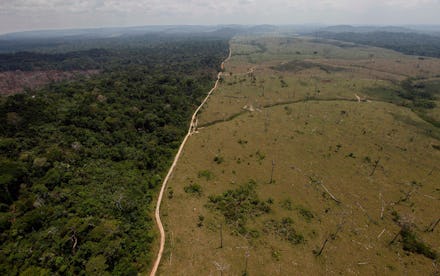There's another part of Brazil that's dying even faster than the Amazon

The Amazon is still burning, but it's not the only environmental crisis Brazil is staring down at the moment. Just a few miles south of the rainforest is Brazil's Cerrado region, a massive, bio-diverse eco-region that stretches for more than 200 million hectares, accounting for more than 21 percent of all land in Brazil. The area serves as home to thousands of different species of plants, animals, and insects and serves as a massive carbon sink, removing carbon dioxide from the atmosphere. Just like the neighboring Amazon, the Cerrado is being destroyed by deforestation — except it's happening at a much faster rate.
To understand how devastating it would be to lose the Cerrado, it's important to know just how unique the region is. Cerrado is what is called "mosaic" habitat, meaning it is made up of multiple types of habitats. This particular one contains savannahs, grasslands, wetlands and forest. Those eco-regions contain more than 200 types of mammals, 800 species of birds, 120 kinds of reptiles, 150 types of amphibians, 1,200 species of fish, 90 million kinds of insects and more than 11,000 plant species. In total, the area is home to five percent of the planet’s animals and plants. According to World Wide Fund for Nature, the Cerrado is one of the most biologically diverse habitats in the world. It is also a particularly important source of water in the region, serving as the starting point for six of Brazil's 12 major hydrological regions. Water originating from the region also serves as a source of electricity for nine out of 10 Brazilians who get their energy from hydroelectric plants.
All of that should present a self-evident case for why protecting the Cerrado is important. Yet, just three percent of the area is considered to be legally protected. The rest is subject to use for all sorts of agricultural purposes. Since the 1950s, the unique landscape has been subject to massive amounts of deforestation. As much as 50 percent of the land has already been deforested, according to the World Wildlife Fund, and more than 70,000 hectares are disappearing every year. By 2030, it is projected that Cerrado will lose tens of millions of additional acres of its native vegetation. As that land disappears, the species that call it home are put in peril. That is particularly troubling because nearly 5,000 species of animal in the Cerrado are considered endemic, meaning they are native to the region. Pushing them out will result in them migrating to unfamiliar habitats where they may be invasive or struggle to survive. Many of the plant species found in the region have yet to be found anywhere else on earth, and destroying their habitat could mean losing those types of plants for good.
Its destruction also means the loss of a significant carbon storage center. According to the World Wildlife Fund, the Cerrado holds about 118 tons of carbon per acre — the equivalent to how much about 25 standard passenger vehicles emit over the course of one year. Greenpeace recently suggested that Cerrado's remaining vegetation could store up to 13.7 gigatonnes of carbon dioxide. For comparison's sake, global carbon emissions from fossil fuel use were just under 9.8 gigatonnes in 2014. The Intergovernmental Panel on Climate Change (IPCC) has warned continued destruction of lands like Cerrado could limit the region's ability to capture carbon, minimizing one of its important purposes in protecting not only the many species that live there, but also the overall wellbeing of the planet.
The cause of the destruction of the Cerrado is the same as the Amazon, though it hasn't captured headlines because there isn't a visually stark image like the landscape set ablaze like there is associated with the rainforest. Instead, since the 1950s, the expansion of soy and beef production has been eating away at the land of the biodiverse region. Brazil and surrounding regions account for as much as 50 percent of the world's soy production. As much as 90 percent of that is used to produce animal feed, according to nonprofit environmental news site Mongabay. Soy has proven to be a massively profitable business for Brazil, becoming one of the nation's top exports, but the harvesting of the product has resulted in the deterioration of the country's incredibly important habitats.
The Cerrado has quietly been victimized by the expansion of these agricultural operations. In the last decade, its land has been subject to nearly all of the expansion of soy production in Brazil, according to TRASE, an organization that tracks commodity supply chains. While nearly the same amount of land has been lost in the Cerrado as in the Amazon in absolute terms, the Cerrado is at a much greater threat because of its level of biodiversity and because much less of it is protected.
As soy production continues to grow, few involved in the chain are interested in solving the problem. According to Mongabay, companies responsible for more than 50 percent of the soy production going on in the region have declined to commit to eliminating deforestation from their supply chain. Likewise, the meat processing companies that require the soy feed for their animals have been almost entirely silent on the issue. Mongabay reported that the three companies that make up nearly 90 percent of all meat sales in the region have failed to make commitments not to purchase any soy that contributes to deforestation. Soy production will continue to expand and the Cerrado will continue to shrink, leading to a slow, unfortunate and unforgivable death for a region of land that is considered to be the birthplace of ecology. Plants and animal species will be lost for good, and the wellbeing of the planet that we live on will continue to deteriorate — all in exchange for some meat.